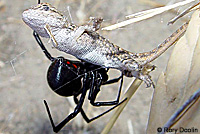Lizard Behavior and Life History -
Hunting, Feeding, Defecating, and Predators


| Also see Lizards eating other Lizards below | |||
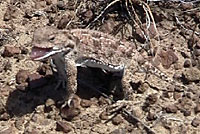 |
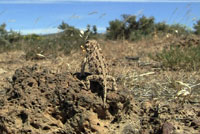 |
 |
 |
| Short Video: On a sunny June day a small adult Pygmy Short-horned Lizard let me follow it around closely as it searched for food, running from one slightly-elevated perch to another, then raising up on all fours and cocking its head from side to side to scan for ants. When an ant was spotted, the lizard quickly ran to it, opened its mouth, and grabbed it with its big sticky tongue. In this video I have edited together several short feeding instances, with most of the running around, searching and waiting for ants to appear removed. |
Short Video: More views of the same Pygmy Short-horned Lizard on the left hunting, feeding on ants, and trying to catch flying bugs. |
Short Video: An Arizona Striped Whiptail eats a small invertebrate. |
Short Video: I crawled under a bush with a friendly Northern Desert Iguana and tossed him a desert willow flower which he gobbled up. Desert Iguanas love those tasty petals. |
 |
 |
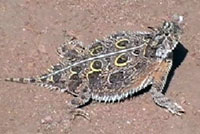 |
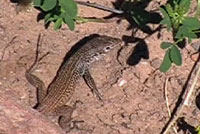 |
| Short Video: A large old male Common Chuckwalla puts on a great show as he basks in the sun, does a few pushups, eats some bushes, then poops. |
Short Video: A LIttle White Whiptail hunting for red ants around an anthill in the white sands of New Mexico. |
Short Video: A Texas Horned Lizard running around. At one point it quickly eats an ant. |
Short Video: A Plateau Tiger whiptail digs in the sand with all four legs looking for food. |
 |
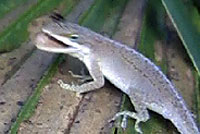 |
 |
 |
| Short Video: Dark phase Great Basin Fence Lizards basking and eating small ants that are crawling over some rocks. |
Short Video: Not all feeding attempts are successful: In this short video, a light-phase Northern Green Anole in Florida tries to catch a fly, but fails. |
Short Video: Green Iguanas are mostly vegetarian. This video shows one munching on some sea grape flowers near a beach in Florida. |
6-year-old lizard wrangler Enzo Forte holds a sub-adult Southern Alligator Lizard that he found trying to kill and eat a potato bug in Ventura County. The lizard continued even after being picked up and struggled with the bug for about an hour before finally severing the bug's head. © Domiane Forte. |
 |
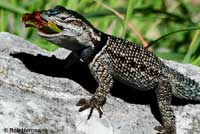 |
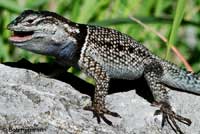 |
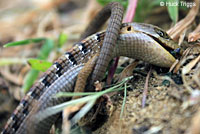 |
| An adult male Yarrow's Spiny Lizard eating a bug in the Huachuca Mountains of Arizona. © Bob Herrmann | A Southern Alligator Lizard eating a beetle. © Huck Triggs | ||
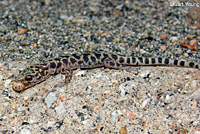 |
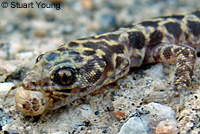 |
 |
 |
| A adult Granite Night Lizard eating a spider at night. © Stuart Young |
A large male Great Basin Collared Lizard eating a small rodent on a cool day in March in Washoe County, Nevada. © Richard Lingo | ||
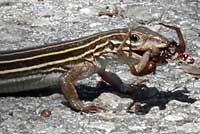 |
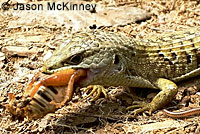 |
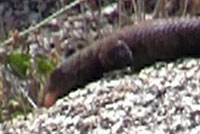 |
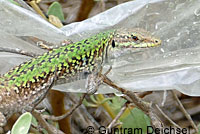 |
| An Eastern Six-lined Racerunner eating an insect in Florida. |
This adult Shasta Alligator Lizard was found eating a huge Jerusalem Cricket © Jason McKinney |
This telephoto enlargement shows a Granite Spiny Lizard using it's large sticky tongue to eat something crawling on a rock. | This adult male Southern Italian Wall Lizard - Podarcis siculus siculus, is drinking drops of rainwater that were trapped on a piece of plastic garbage at a Roman archaeological ruin site on Sardinia, Italy. © Guntram Deichsel |
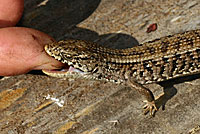 |
 |
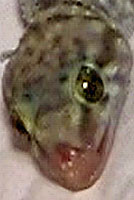 |
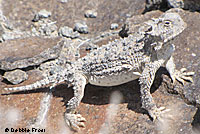 |
| An adult San Francisco Alligator Lizard tries to eat a lizard photographer. The attempt was unsuccessful. | Short Video: A Great Basin Whiptail in the Kern County Mohave Desert digs around looking for food, then eats a red ant, but has trouble with it. |
A Mediterranean Gecko shows its tongue when it licks its lips after eating a flying insect. |
When horned lizards are actively hunting, they stand up high on their legs, often standing on a rock to help them raise up higher off the ground. They do this to increase their field of vision. When they see a bug moving, then they run quickly toward it. This Northern Desert Horned Lizard let the photographer get very close then ran towards her to catch a fly. © Debra Frost |
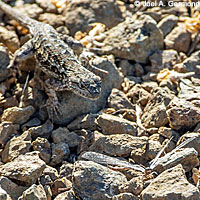 |
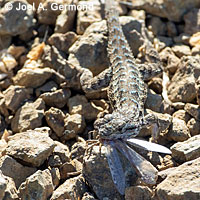 |
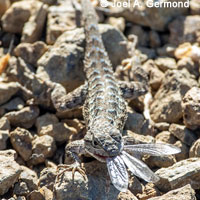 |
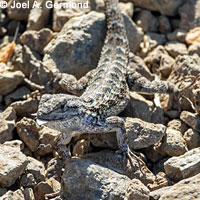 |
| This San Luis Obispo County Coast Range Fence Lizard crept up to an adult Antlion, lunged to catch it, then swallowed it whole. © Joel A. Germond | |||
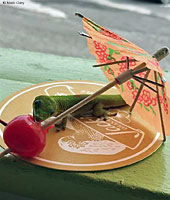 |
 |
 |
 |
| The Gold Dust Day Gecko is a species that has been introduced on the island of Hawaii. It's known to consume invertebrates, flower pollen, nectar, and soft fruit, which includes the cherries stuck to the umbrellas in tropical drinks. © Mark Gary | Adult Coastal Whiptail eating a potato bug, Los Angeles County © Joel A. Germond |
Adult Coastal Whiptail eating a Jerusalem Cricket in the Santa Monica Mountains, Los Angeles County © Max Roberts |
|
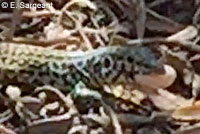 |
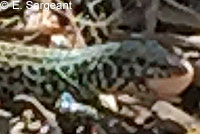 |
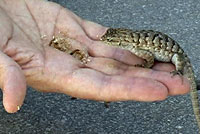 |
|
| This juvenile California Whiptail was observed in Santa Barbara County eating a small leathery egg, possibly a lizard or snake egg. The whiptail worked the egg around in its mouth for quite awhile, then spat it out half deflated, flicked its tongue out for awhile, then picked it back up, and swallowed it completely. © E. Sergeant | This YouTube Video from Reptiles4U made in 2010 in an Inyo County yard shows several wild lizards eating meal worms offered by humans. The note for the video includes these comments: "...meal worms are not good for the health of lizards on a regular basis and I rarely fed them. When they see you are a source of food, these lizards make friends with you right away." |
||
| Lizards Defecating | |||
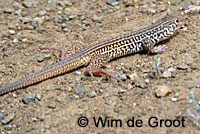 |
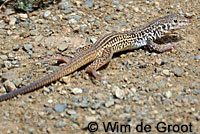 |
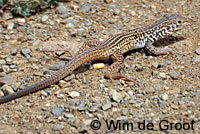 |
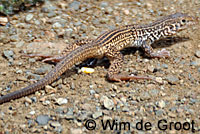 |
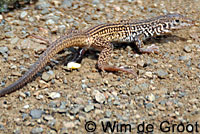 |
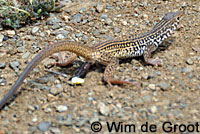 |
 |
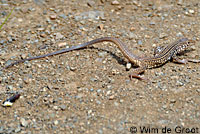 |
| This is a series of pictures showing how a California Whiptail defecates. (Viewed sequentially from top row left to right, then bottom row left to right.) The white part is a solid plug of uric acid, which is followed by the darker feces. © Wim de Groot |
|||
 |
 |
||
| Short Video: A Northwestern Fence Lizard does his business for the camera, then runs towards it. |
Short Video: A large old male chuckwalla gets some sun, does some pushups, eats some plants, then poops. |
||
| Lizard Predators | |||
| Lizards Eating Lizards | Snakes Eating Lizards | Birds Eating Lizards | Miscellaneous Lizard Predation |
Lizards Eating Other Lizards |
|||
 |
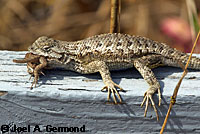 |
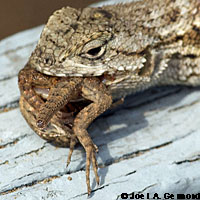 |
|
| An adult Coast Range Fence Lizard eating a juvenile of the same species in San Luis Obispo County. © Joel A. Germond | |||
 |
 |
||
| Adult Long-nosed Leopard Lizard eating a Great Basin Whiptail on a road in San Bernardino County. (It is not known if the whiptail was killed by the Leopard Liard or if it was dead before it was consumed. © Alexandra Hicks |
This juvenile Long-nosed Leopard Lizard is eating a juvenile Great Basin Whiptail in Inyo County. Swallowing the complete tail is probably going to take some time. © Jaye B |
||
Snakes Eating Lizards |
|||
 |
 |
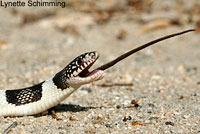 |
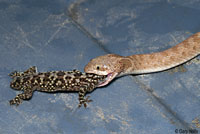 |
| This series shows a Long-nosed Snake eating a Great Basin Whiptail © Lynette Schimming. | A captive Texas Nightsnake eats a Mediterranean Gecko. |
||
 |
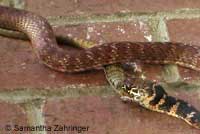 |
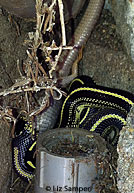 |
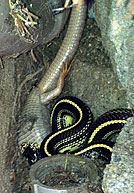 |
| A Red Racer eating a Southern Alligator Lizard © Samantha Zahringer. Samantha Zahringer watched this coachwhip eat the lizard by her back door. Her kids saw the snake attack the lizard. It raised its head and neck off the ground, swayed for a moment, then struck quickly. Two other lizards nearby froze while the snake swallowed its meal, then they ran away quickly. |
This striped California Kingsnake is eating a Southern Alligator Lizard in San Diego County. © Liz Samperi | ||
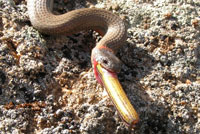 |
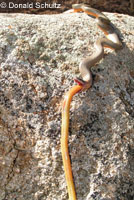 |
 |
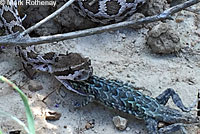 |
| Ring-necked Snakes use a mild venom to subdue their prey which include snakes and lizards. After being handled, this ring-necked snake from San Diego County regurgitated a San Diegan Legless Lizard that it had recently eaten. © Donald Schultz | This juvenile Southern Pacific Rattlesnake was observed eating a Western Side-blotched Lizard that had been killed on a trail and was dead for some time before it was found by the snake, which took advantage of a free meal. © Mark Rothenay |
||
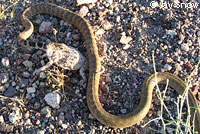 |
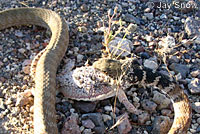 |
 |
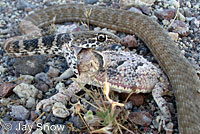 |
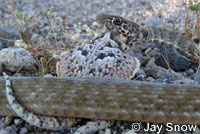 |
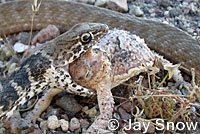 |
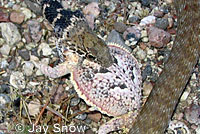 |
 |
| Jay Snow took this series (left to right, top to bottom) of a Red Racer trying to eat a live Southern Desert Horned Lizard over a period of 44 minutes. The snake failed to swallow the lizard and crawled away. In the last picture you can see that the lizard lay prone for several minutes after the coachwhip left then took up to 15 minutes to clean the saliva off its face before slowly walking away, no doubt thankful for the row of horns behind its head. © Jay Snow |
|||
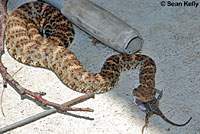 |
 |
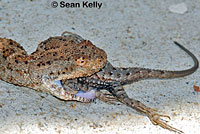 |
 |
| Sean Kelly found this juvenile Southwestern Speckled Rattlesnake eating a Great Basin Fence Lizard behind his garbage can one afternoon in San Diego County. © Sean Kelly |
Desert Striped Whiptail, eating a Great Basin Whiptail, © Ceal Klinger | ||
 |
 |
 |
 |
| An adult Red Diamond Rattlesnake eating a Coast Horned Lizard in San Diego County © Shane Caver | A Coast Patch-nosed Snake trying to kill and eat a Coastal Whiptail in San Diego County © Tom Day Watch a video of this at the link below. |
||
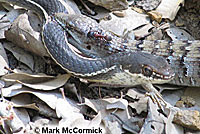 |
 |
 |
 |
| Sometimes the predator loses the battle and becomes the victim. This series shows a Southern Alligator Lizard biting onto the neck of a lizard-eating California Striped Racer. After the lizard finally let go, the snake quickly raced up a steep 15 foot high cliff up into some branches. © Mark McCormick |
A California Kingsnake has captured a Southern Alligator Lizard in San Luis Obispo County and is constricting the lizard in its coils. © Grigory Heaton | ||
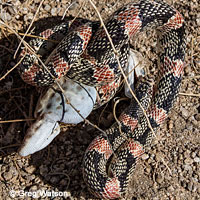 |
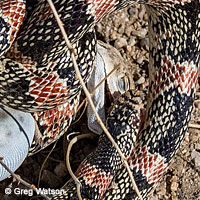 |
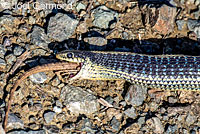 |
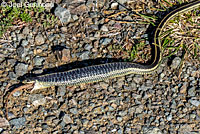 |
| Battle of the Long-Noses An adult Long-nosed Snake was found in Kern County coiled around a Long-nosed Leopard Lizard, attempting to swallow the lizard. The lizard managed to keep its mouth outside the snake's mouth and after 20 minutes, the lizard was able to escape the snake's coils and quickly limp away. It's not known if the lizard survived or died later from its injuries. © Greg Watson |
Coast Gartersnake eating a Coast Range Fence Lizard in San Luis Obispo County © Joel Germond |
||
 |
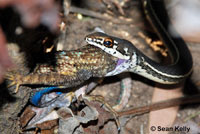 |
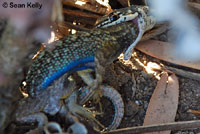 |
 |
| This series shows a California Striped Racer eating a male Great Basin Fence lizard in San Diego County. © Sean Kelly | A California Kingsnake eating a Pacific Gophersnake in Santa Clara County © Faris K |
||
 |
 |
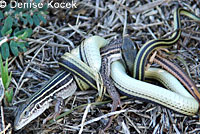 |
 |
| A Texas Patch-nosed Snake captures a Texas Spotted Whiptail, biting its tail and wrapping its body around the lizard's body to suffocate it. The snake dragged the lizard away before the observer could tell if it successfully killed and ate the lizard. Central Texas, © Denise Kocek. |
A Coast Patch-nosed Snake constricts a Coastal Whiptail in Los Angeles County © Anonymous, Picture courtesy of Brian Hubbs. | ||
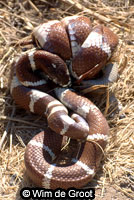 |
 |
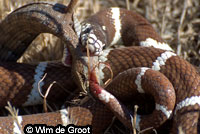 |
|
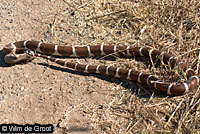 |
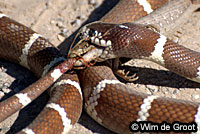 |
 |
|
| This California Kingsnake was observed battling a Southern Alligator Lizard on a hiking trail in Santa Clara County. The alligator lizard clamped its jaws down on the snake's tail and held on tight even after it died. The snake had to pull and thrash about for more than 20 minutes before the lizard let go of the badly-damaged tail, finally allowing the snake to swallow it. © Wim de Groot | |||
 |
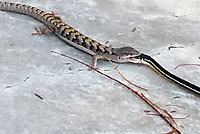 |
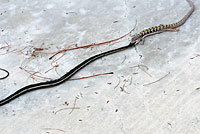 |
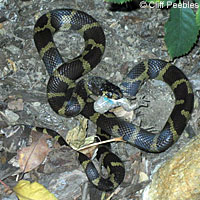 |
| This Southern Alligator Lizard was found biting the head of a California Striped Racer on a driveway in Riverside County. My guess is that the snake tried to eat the lizard which successfully by clamping down on the snake's head. The outcome is unknown. | A California Kingsnake eats a Great Basin Fence Lizard in Orange County © Cliff Peebles |
||
 |
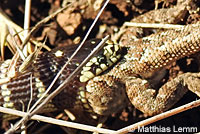 |
||
| Adult California Kingsnake eating a Side-blotched Lizard, Santa Catalina Island © Matthias Lemm | |||
Birds Preying On Lizards |
|||
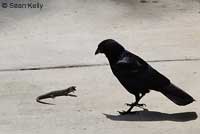 |
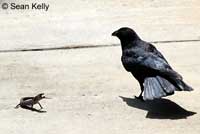 |
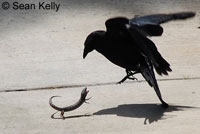 |
|
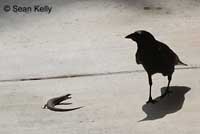 |
 |
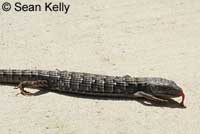 |
|
| Sean Kelly shot this amazing series of pictures that show a fearless Southern Alligator Lizard successfully defending itself against an American Crow. |
|||
 |
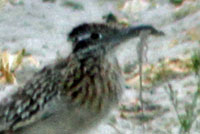 |
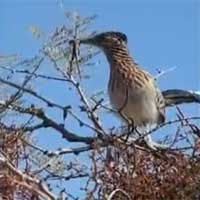 |
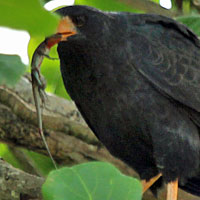 |
| Roadrunners prey on whiptails and other lizards. This one has caught a Desert Grassland Whiptail in Arizona. | I saw this Long-tailed Brush Lizard fall prey to a Roadrunner, then I chased the bird around a fruit orchard for 15 minutes like a deranged Wile e Coyote until it stopped long enough for this fuzzy telephoto shot. | Click to see a YouTube video of a cooing Roadrunner in San Bernardino County with a Great Basin Whiptail in its bill. | Hawks and other raptors include lizards among their prey. This Black Hawk was photographed high up a tree in Costa Rica with a fresh-caught lizard in its bill. © Joel A. Germond |
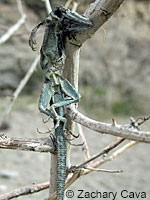 |
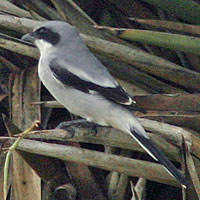 |
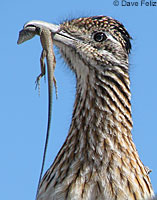 |
|
| This Long-tailed Brush Lizard has been hung on thorns of a shrub in the Clark County Nevada desert by a Shrike similar to the one seen to the right. © Zachary Cava |
The Loggerhead Shrike is a common predatory songbird in the North American deserts. Their prey includes lizards, which they sometimes kill then save to eat later by hanging them on thorns or even barbed wire. | A Greater Roadrunner with a freshly killed Great Basin Whiptail. © Dave Feliz You can also watch a short YouTube video of this bird perched on top of a bush with the lizard in its beak as it sings. After singing it flew down to its nest in a cholla cactus where it probably fed the whiptail to its young. |
|
Miscellaneous Predators and Unintended Predation |
|||
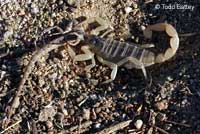 |
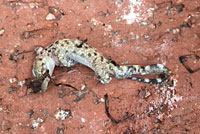 |
||
| This hatchling Coast Range Fence Lizard has been preyed upon by a black widow spider. © Rory Doolin | Western Side-blotched Lizards are low on the food chain, falling prey to many predators, including desert scorpions. © Todd Battey |
An adult Mediterranean Gecko would probably eat a spider, but this juvenile gecko was found in Orange County killed by another alien species, a brown widow spider. © Larry Bowman | |
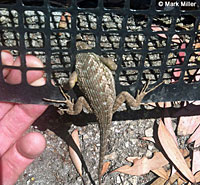 |
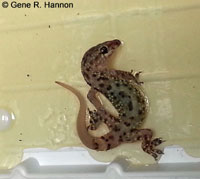 |
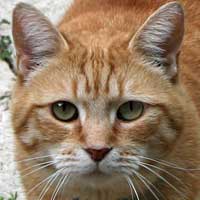 |
|
| Plastic mesh fencing can unintentionally trap and kill lizards. © Mark Miller | Sticky glue traps can also unintentionally trap and kill lizards. © Gene R. Hannon | House Cat or Domestic Cat - Felis catus Domestic cats will kill and sometimes eat just about any small moving animal that they can catch including lizards they find in the yard, in the house, or wherever the cats roam. Outdoor pets and feral cats have decimated small wildlife in some areas. They seem to continue killing even if they don't need to eat their kill. This is one of many good reasons to keep your cat indoors, although sometimes that's impossible. (This bad boy was a rescued feral cat who refused to stay inside and eat only processed cat food. He insisted on roaming around outside the house where he sometimes ate live lizards, mice, birds - things he probably had to eat when he was feral.) |
|
Return to the Top
© 2000 -

